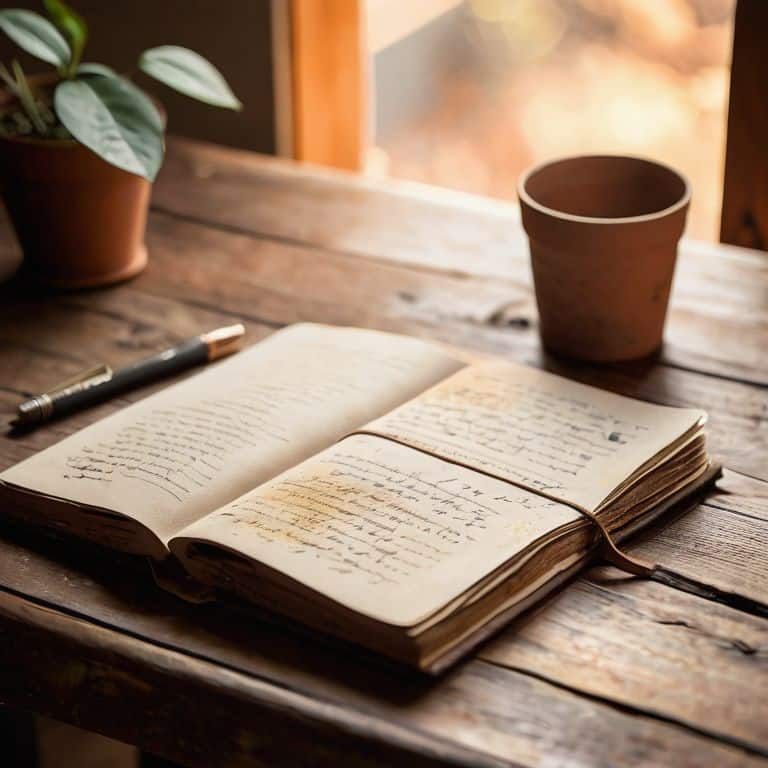I still remember the day I stumbled upon an article touting the benefits of a gratitude journal as a magical cure-all for mental health. The idea that simply writing down three things I’m thankful for each day would suddenly make all my problems disappear seemed like a simplistic cop-out. As someone who’s spent years documenting the beauty in brokenness through my photography, I knew that true healing required a more nuanced approach. I’ve always been drawn to the imperfect, the unpolished, and the unvarnished stories of struggle and resilience.
My goal with this article is to offer a no-nonsense exploration of how a gratitude journal can actually help you navigate life’s challenges. I’ll share my own experiences, including the times when writing in my journal felt like a sorely needed release, and the times when it felt like a forced exercise in positivity. I promise to provide honest, experience-based advice that acknowledges the complexities of mental health and the importance of embracing our imperfections. By the end of this article, you’ll have a clearer understanding of how a gratitude journal can be a powerful tool for personal growth, rather than just a fleeting trend or a quick fix.
Table of Contents
Fractured Light

As I reflect on my journey with a gratitude journal, I’m reminded of the power of mindfulness that it’s brought into my life. It’s not just about writing down things I’m thankful for; it’s about practicing mindfulness through journaling, being present in the moment, and acknowledging the beauty in the brokenness. On my worst days, when the darkness closes in, I find solace in the daily gratitude prompts that help me shift my focus towards the positive aspects of my life.
I’ve come to realize that reflecting on gratitude in difficult times is not about ignoring the struggles, but about finding the strength to face them head-on. The science behind gratitude and happiness is fascinating, but for me, it’s not just about the science – it’s about the personal experience of finding joy in the midst of chaos. By creating a gratitude practice for stress relief, I’ve learned to calm my mind and soothe my soul, even in the most turbulent of times.
My gratitude journal has become a sanctuary, a place where I can reflect on gratitude in difficult times and find peace. It’s not a magic solution, but it’s a daily reminder of the beauty that still exists, even in the darkest of days. As I look back on my journey, I’m grateful for the lessons learned and the strength gained from gratitude journaling for anxiety and depression. It’s a journey that’s not always easy, but it’s one that’s worth taking, one step at a time.
Daily Gratitude Prompts for Mental Wellness
As I delve into my gratitude journal, I find that daily reflections help me stay grounded. I’ve started to notice the small things – a good cup of coffee, a beautiful sunset, or a warm conversation with a friend. These moments may seem insignificant, but they add up and help shift my perspective.
By incorporating mindful prompts into my journaling routine, I’ve been able to cultivate a sense of gratitude even on tough days. I ask myself questions like “What did I learn today?” or “What am I looking forward to?” and it helps me focus on the present moment, rather than getting caught up in worries about the past or future.
Practicing Mindfulness Through Journaling
As I delved deeper into the world of gratitude journals, I discovered that practicing mindfulness was a crucial aspect of the journey. It’s about being present in the moment, acknowledging the imperfections, and finding beauty in the brokenness. My camera, once a tool for capturing the world around me, now helps me focus on the smallest details, teaching me to appreciate the intricate web of life.
Through journaling, I’ve learned to slow down, to let go of the need for perfection, and to embrace the imperfections that make life worthwhile. It’s in these quiet moments, surrounded by the scratches and scuffs of my old motorcycle, that I find solace in the imperfections, and my mind begins to heal.
Benefits of a Gratitude Journal

As I reflect on my journey with gratitude journaling, I’ve come to realize that practicing mindfulness through journaling has been a pivotal aspect of my mental wellness. By dedicating a few minutes each day to write down the things I’m grateful for, I’ve been able to shift my focus away from stress and anxiety. It’s not always easy, but the science behind gratitude and happiness is clear: when we focus on what we have, rather than what we lack, our brains begin to rewire themselves for positivity.
I’ve found that using daily gratitude prompts for mental wellness has helped me stay on track, even on days when it feels like there’s nothing to be grateful for. It’s amazing how a simple prompt can help us uncover the hidden gems in our lives. Whether it’s a beautiful sunset, a good cup of coffee, or a supportive friend, creating a gratitude practice for stress relief has been a game-changer for me.
In difficult times, it’s easy to get caught up in negative thoughts and emotions. But I’ve learned that reflecting on gratitude in difficult times can be a powerful way to reframe our experiences and find the lessons within them. By focusing on what we’re grateful for, we can begin to heal and move forward, even in the face of adversity. This is especially true for those struggling with gratitude journaling for anxiety and depression, as it provides a healthy outlet for emotions and a reminder of the good things in life.
Reflecting on Gratitude in Difficult Times
As I sit here, reflecting on my journey with gratitude, I’m reminded that it’s not always easy to find the silver lining in difficult times. There have been days when the rain poured down, and my motorcycle broke down on the side of the road, leaving me to wonder if I’d ever find my way again. But it’s in those moments that I’ve learned to lean into my gratitude practice, to seek out the small joys that can be easily overlooked.
I’ve come to realize that gratitude is a muscle that needs to be exercised, even when it feels like the last thing I want to do. By acknowledging the tiny fragments of beauty in the brokenness, I’ve been able to shift my perspective, to find a sense of peace that eludes me when I’m focused solely on the struggle.
The Science Behind Gratitude and Happiness
As I delved into the world of gratitude journals, I became fascinated by the intricate dance between gratitude and happiness. It’s a complex relationship, one that scientists have been studying for years. Research has shown that practicing gratitude can actually rewires our brain, increasing the production of neurotransmitters like dopamine and serotonin.
The neuroplasticity of gratitude is a powerful concept, one that suggests our brains can be reshaped by our experiences and thoughts. By focusing on what we’re thankful for, we can create new neural pathways that help us navigate life’s challenges with more resilience and optimism. This, in turn, can lead to a deeper sense of happiness and fulfillment.
Finding Solace in the Fractures: 5 Key Tips for Harnessing the Power of a Gratitude Journal
- Embracing the Imperfections: Don’t worry if your journal isn’t perfect – it’s the raw, unedited moments that often hold the most beauty and truth
- Beyond the Surface Level: Dig deeper than just listing things you’re grateful for – explore why they matter, how they make you feel, and the stories behind them
- Gratitude in the Dark Times: It’s easy to focus on the good when life is going well, but it’s in the tough moments that a gratitude journal can be a powerful tool for finding hope and resilience
- Making it a Ritual: Incorporate your gratitude journal into your daily routine, whether it’s first thing in the morning or before bed – consistency is key to making it a lasting habit
- Looking Back to Move Forward: Periodically reflect on past entries to see how your perspective has shifted, what patterns emerge, and how you can apply those insights to the present and future
Key Takeaways from My Journey with Gratitude
I’ve learned that writing down the things I’m grateful for each day can be a powerful tool for finding beauty in the brokenness, even on my worst days
Practicing mindfulness through journaling and using daily gratitude prompts can help shift my focus away from the darkness and towards the light, no matter how small it may seem
Reflecting on gratitude in difficult times has taught me that true strength is forged in the cracks, and that it’s okay to not be okay – it’s how I respond to those struggles that really matters
A Reflection of Resilience
The benefits of a gratitude journal aren’t about glossing over the cracks, but about learning to find the light that seeps through them – it’s in those moments of raw, unfiltered honesty that we discover our true strength.
Rowan Croft
Embracing the Beauty of Brokenness

As I look back on my journey with gratitude journaling, I’m reminded that it’s not about fixing our brokenness, but about finding beauty in the cracks. Through practicing mindfulness, using daily gratitude prompts, and reflecting on the science behind gratitude and happiness, I’ve come to realize that true strength lies in our ability to acknowledge and learn from our imperfections. By embracing this mindset, we can begin to see the world in a different light, one that is filled with fractured light and beautiful imperfections.
So, as you close this chapter and embark on your own journey with gratitude journaling, I want to leave you with a final thought: true freedom lies in our ability to find beauty in the brokenness. Don’t be afraid to get real, to confront your struggles and imperfections head-on, because it’s in those moments that we discover our greatest strengths. Remember, it’s okay to not be okay, and it’s in those moments of vulnerability that we find the courage to heal, to grow, and to rise above the noise.
Frequently Asked Questions
How can I make gratitude journaling a consistent habit in my daily life?
For me, consistency came from making gratitude journaling a non-negotiable part of my daily routine, like brushing my teeth or taking a morning walk. I keep my journal next to my bed, so it’s the first thing I see in the morning, and I’ve committed to writing in it every day, no matter what – even if it’s just a few scribbled lines.
What if I'm having trouble thinking of things to be grateful for, are there any prompts or exercises that can help?
Honestly, I’ve been there too – some days it feels like nothing’s going right. That’s when I turn to prompts like writing down three things I’m thankful for, no matter how small they seem, or describing a moment from my day that brought me joy. It’s not about forcing it, but about training my mind to see the beauty in the brokenness.
Can gratitude journaling really have a significant impact on my mental health and wellbeing, or is it just a temporary feel-good practice?
Honestly, I’ve seen it transform my own mental health – it’s not just a fleeting feel-good thing. By acknowledging the cracks, the struggles, I’ve found a sense of resilience, of hope, that sticks with me long after I close the journal. It’s about embracing the brokenness, not just slapping a Band-Aid on it.
